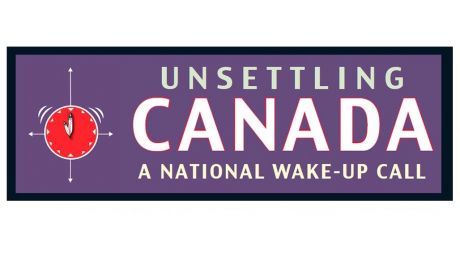Arts
You are here
Book review: Unsettling Canada, A National Wake-Up Call

November 1, 2017
Arthur Manuel (Neskonlith First Nation, BC) died earlier this year and will be remembered as a strong defender of Indigenous rights.
His book Unsettling Canada is a political autobiography that describes campaigns undertaken by Manuel and shines a light on other actions with national and international implications. By sharing the details of ongoing struggles, Manuel provides useful lessons for campaigners in any progressive movement.
Red Power movement
Manuel cut his activist teeth during the time of the 1960s/70s Red Power movement. He acknowledges the influence of other social justice and liberation movements of the time. In Alberta where he lived for a period in his youth, along with other activists he initiated practical actions like drop-in centres, political workshops, prison visits, and organizing sit-ins at government offices.
At the same time, First Nations began a series of court cases to try and win their rights, the most basic one being the recognition of title to their territory. 1973 saw the Calder decision regarding Nisga’a territory in northern BC. This was the first time “Indian title” had been recognized in law.
Returning to live in BC during the 1980s (after almost completing a law degree), Manuel became involved in actions that asserted Indigenous control of fisheries and child welfare. Then he joined his father in the struggles of the 1980s associated with enshrining Indigenous rights in the repatriated constitution.
Constitutional rights
In “The Constitution Express: a Grassroots Movement”, Manuel takes us beyond the mainstream’s fixation with suits in Ottawa to the community frontlines. “My own role in the protest was minor, but I was at the Ottawa Central Station when the train pulled in on the morning of November 28, 1980. Two trains, with more than a thousand protesters on board, had left Vancouver…In BC hundreds of Indians had met the trains as they passed through the towns and cities along the route. In Alberta, the crowds reached the thousands.” This groundswell was caused by Pierre Trudeau’s government’s plan “that did not include a word about Aboriginal title or rights.”
The situation also created an opportunity for allies to show their support. Manuel praises Ottawa Mayor Dewar’s call to residents to billet the protesters, which succeeded in providing more than enough spaces!
Protest worked, resulting in Section 35(1) of the Constitution Act, 1982: “The existing aboriginal and treaty rights of the aboriginal peoples of Canada are hereby recognized and affirmed.”
Rights ignored
Manuel describes the hugely important, precedent-setting Delgamuukw decision (1997), Tsilhqot’in decision (2014), and others. But these legal successes were never respected by provincial or federal governments, who used every delay and obstruction to continue to withhold justice. Most recently, there was a decision by the national Human Rights Commission that agreed with the case brought forward by the First Nations Child and Family Caring Society, which ordered the federal government to fund child and family services to First Nations on par with what they provide provincial governments. Three years later the government has yet to pay up.
Because of this obstruction, Manuel and others turned to other tactics, for example meeting with major investment institutions to persuade them against investing in projects like pipelines that threaten indigenous territory.
They also look to wins like the UN Declaration on the Rights of Indigenous Peoples as another way to influence government policy.
But Manuel always supported assertion (“direct action”) as a key tactic and describes the many battles of the Secwepemc people (of which his community is a member), who are currently building “Tiny Houses” to stop construction of the Kinder Morgan pipeline.
How will Indigenous rights be won?
Even when favourable decisions are made by the courts, or when something like the UN Declaration on the Rights of Indigenous Peoples is ratified, there still needs to be “negotiation” with the state to implement these decisions. But the state ensures that these hard-won rights will not be achieved beyond what is on paper.
What is the alternative? Struggles for Indigenous rights will always be led by Indigenous peoples themselves, who are also leading the climate justice movement. Mass organizations of non-Indigenous peoples—like trade unions, student unions, civil justice groups, etc—need to take Indigenous struggles more seriously and with greater numbers than shown to date. Ultimately we must overthrow capitalism and its colonial state—combining national liberation and working class revolution—to save our planet and to achieve justice for all, including the First Peoples of Turtle Island.
As Red Power activist Howard Adams explained, “Mobilization of the masses of Indian and Metis is still centered around local community struggles. However, as the struggle widens, social class features will gradually become more prominent and the movement will turn into a class struggle…Radical nationalism will mean greater class consciousness. It develops the understanding that a native liberation struggle is essentially the same struggle as that of the working class and all oppressed people against a capitalist ruling class. In this way, Indians and Metis can build alliances with workers and other oppressed and colonized groups of white society.”
Section:










